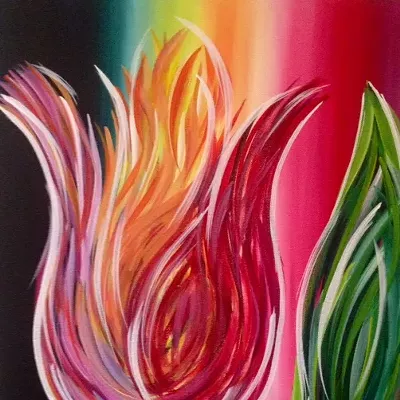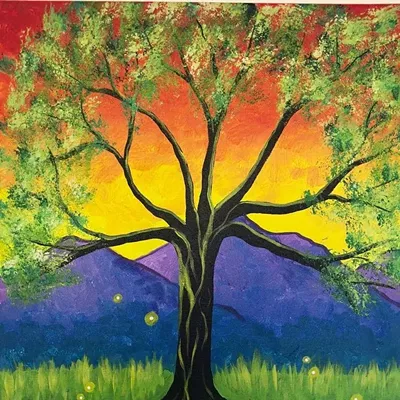The baby Murray nuzzles his mother's chest. The naked toddler shyly poses with his sister. The blond boy romps on the beach, plays soccer with his mates and tumbles in for an unruly class portrait. What the pictures don't show is that during the long years that Murray was thus pleasurably engaged, Nelson Mandela was languishing in the notorious prison of Robben Island. While Murray was smearing his white skin with blackface for a Zulu costume, black kids his own age were scrambling just to stay alive in impoverished segregated townships. And just before Murray started ogling girls and mugging with his fellow art students, Steve Biko was murdered in prison.
"Guilt and Innocence, 1960-1990," Murray's installation piece, chronicles the life he led before coming to political consciousness. Made in 1998, it signals Murray's belated recognition that his privilege came at a price: the long and brutal suppression of his nation's black majority. While it's not the most interesting piece aesthetically in the big exhibition Liberated Voices: Contemporary Art from South Africa, "Guilt and Innocence" starkly delineates the utter separateness of black and white life under apartheid.
The show, curated by Laurie Ann Farrell of the Museum for African Art in New York City, gathers together the work of 13 black and white artists made since "liberation" in 1994. Apartheid made South Africa more or less anathema in the world community, and its artists were virtually unknown in international art circles. Full of pent-up energy and rage, the artists on exhibit burst out of that longtime anonymity here, seeming to emerge fully formed from a place that's been just as hidden to us as Murray's black countrymen once were to him.
The influences of African traditional arts are everywhere, even in the works of white artists trained in European styles. Claudette Schreuders' has made stocky little carved and painted figures, totemic images of mothers and fathers and children that owe their truncated shapes to tribal art. Only one of them features a black and white person together: a black nanny holding a white baby, an acknowledgment of one of the few intense interracial relationships permitted in the bad old days. Samson Mnisi's updated shields are beautiful compositions of reeds, cloth and found objects. Similarly, Thabiso Phokompe has made compelling contemporary abstractions out of ground pigments, cloth, sharp sticks and beads. Dyed the colors of the earth in maroon and brown, the pieces blend the visually rich imagery of traditional ritual with modernist concerns, serving as a metaphor for Africa today.
Naturally, overtly political art abounds. A number of the pieces deal with the death of the black leader Steve Biko at the hands of security police in 1977. Paul Stopforth responded to the death early on, in 1979, with "The Interrogators," an austere black-and-white drawing in graphite in wax. It's a head-on close-up of three officers who tortured Biko, who died after less than a month in police custody. But Biko's story resurfaced vividly for younger artists during the mid-'90s hearings by a government investigative body called the Truth and Reconciliation Committee. In 1998, David Kolohane produced an anguished series of colored drawings in acrylic and oil pastel on paper, as emotionally charged as the work of the German expressionists. These flaming orange night scenes of torture are full of car headlights, phalanxes of men and Biko's broken body pulled in all directions.
Few of the artists stick to conventional media boundaries. Though there are some straight photographs, sculptures and drawings, most of the pieces fall exuberantly outside traditional genre categories. Videos (Penny Siopis) and knitted sweaters (Bridget Baker) are on the roster, as are works fashioned of dirt and rock and trashbags. One artist, Sandile Zulu, even lists fire as an ingredient of his incendiary works, large painterly constructions of burnt newspaper and metal.
Most spectacular of all are the melted trashbag paintings of Mbongeni Richman Buthelezi, who recycles the plastic shopping bags that litter lives worldwide. Instead of entombing them more or less permanently under the sink as the rest of us do, Buthelezi has turned them into "paint" whose colors are brilliant, shockingly so, great swathes of vermilion and ochre, chocolate and sky blue. This innovative material is shaped into gorgeous compositions that loosely suggest crowds of people. In "Untitled," 1997, a powerful human form seems to holding up a fallen comrade, while "Untitled," 1999, suggests a mob heading for chaos, a riot of textures and patterns set against inky black. In Buthelezi's brilliant synthesis, the creased and burnt plastic manages to evoke at one and the same time the colorful fabrics of traditional Africa and the extravagant waste of modern capitalism, as well as the years of oppression and the urban squalor doled out to modern South African blacks.
The painter Willie Bester also scavenges in the trash bin. His assemblage "X Roads, 1994," is a contemporary altarpiece, with a triptych of township residents presiding over an expanse of twisted wire, bent tin cans, and crumbling newspapers. An older man and woman, wrinkled but enduring, flank a tangle of young boys, all of them painted in vivid hues in oil.
It's a cliché to speak of colorful Africa, but photographer Zwelethu Mthethwa, who snaps color portraits of black people in their homes, makes of color a political statement. "I do not believe poverty is equal to degradation," he declares in an artist's statement. "For me color restores people's dignity; I ask myself why we as photographers should deny these people color while it plays such an important part in their lives."
His bright pictures are reminiscent of Louis Carlos Bernal's pungent photos of Tucsonans in their barrio homes. A young woman in plaid poses with her red-and-white bicycle, set in front of a wall covered in printed teal cloth. An older, turbaned woman does the day's cooking in a room rendered vivid by newsprint on the walls. Her T-shirt is canary yellow. Alive and writhing, Mthethwa's rich colors make a vivid contrast to the washed-out, fading portraits of Murray's lost youth, lived in the pallid days of black and white. The art in this show makes a fine prismatic metaphor: Nowadays South Africa is a country not only in black and white, but in every color possible.














